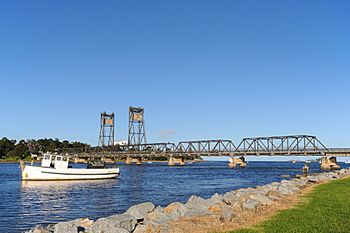Clyde River (New South Wales) facts for kids
Quick facts for kids Clyde River |
|
|---|---|

Clyde River flowing under the bridge at Batemans Bay
|
|
| Native name | Bhundoo |
| Other name(s) | "deep water "Yuin |
| Country | Australia |
| State | New South Wales |
| Region | South East Corner (IBRA), South Coast |
| Local government areas | Shoalhaven, Eurobodalla |
| City | Batemans Bay |
| Physical characteristics | |
| Main source | Budawang Mountains, Great Dividing Range near Kangaroo Hill, within Budawang National Park 597 m (1,959 ft) |
| River mouth | Tasman Sea, South Pacific Ocean Batemans Bay |
| Length | 102 km (63 mi) |
| Depth |
|
| Basin features | |
| Basin size | 1,723 km2 (665 sq mi) |
| Tributaries |
|
The Clyde River (Aboriginal: Bhundoo) is an open intermediate tide dominated drowned valley estuary; or perennial river that flows into the Tasman Sea, located in the South Coast region of New South Wales, Australia.
Contents
Course and features
The Clyde River rises below Kangaroo Hill in the Budawang Range, part of the Great Dividing Range, within Budawang National Park, south of the locality of Sassafras, and flows generally southwards parallel to the east coast, joined by nine tributaries including the Bimberamala, Yadboro, and Buckenbowra rivers, before turning east and reaching its mouth of the Tasman Sea at Batemans Bay. The river descends 601 metres (1,972 ft) over its 102 kilometres (63 mi) course.
The lower reaches of the Clyde River form a substantial estuary up to 30 kilometres (19 mi) from its mouth which is navigable by small vessels to Nelligen, with a tidal ebb of up to 1.28 metres (4 ft 2 in). The coastal estuary covers a catchment area of 1,723 square kilometres (665 sq mi) and contains approximately 50,737 megalitres (1,791.8×106 cu ft) of water over an estimated surface area of 17.5 square kilometres (6.8 sq mi); and at an average depth of 3 metres (9.8 ft).
The river is one of the last major rivers in eastern Australia that has not been dammed. Porters Creek, a tributary of one of the Clyde's tributaries, Pigeon House Creek, is dammed by the Porters Creek Dam, which supplies water to coastal towns.
In its upper reaches, the river forms within the Budawang National Park; while in its lower reaches, the river flows through the Clyde River National Park.
Water quality of the basin is very good. The upper catchment is heavily timbered (state forests and national parks); there is a small amount of logging in the Yadboro State Forest. There are no polluting industries in its catchment, nor any sewage outflows, and thus the river has a reputation for the cleanest, least polluted waters of any major river in eastern Australia.
Etymology
The river was known to Indigenous Australians as the Bhundo.
The river was named after the River Clyde in Glasgow, Scotland, by Lieutenant Robert Johnston who navigated the river aboard the cutter Snapper on 1 December 1821.
Crossings
The river crossings, from its headwaters to its river mouth, include:
- Yadboro Flats bridge, from Yadboro Road to Western Distributor Road, downstream from the junction with Yadboro River.
- Clyde Ridge Road bridge.
- Shallow Crossing, on The River Road, a concrete causeway/ford, at the tidal limit of the Clyde estuary.
- Nelligen bridge, on the Kings Highway.
- Batemans Bay bridge, on the Princes Highway.
Gallery
-
Early morning mist on the Clyde River at Nelligen, 2008.
-
Clyde River, looking upstream from Batemans Bay towards the Budawang Range, 2009.
-
Wharf at Nelligen formerly used by the Illawarra Steam Navigation Company.




